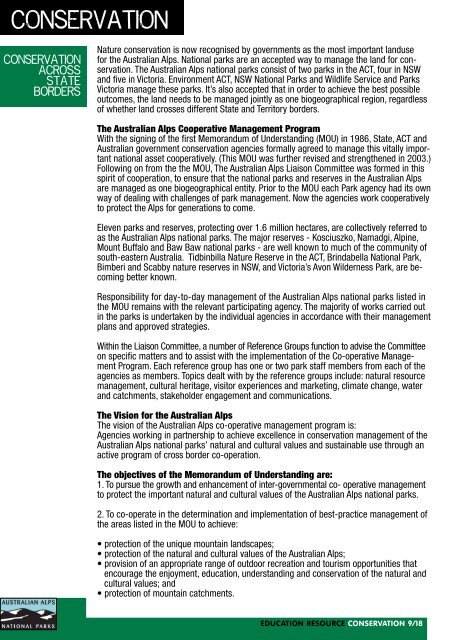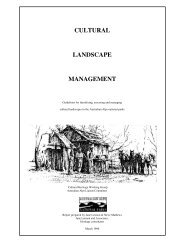Conservation in the Australian Alps - Australian Alps National Parks
Conservation in the Australian Alps - Australian Alps National Parks
Conservation in the Australian Alps - Australian Alps National Parks
You also want an ePaper? Increase the reach of your titles
YUMPU automatically turns print PDFs into web optimized ePapers that Google loves.
CONSERVATION<br />
<strong>Conservation</strong><br />
across<br />
state<br />
borders<br />
Nature conservation is now recognised by governments as <strong>the</strong> most important landuse<br />
for <strong>the</strong> <strong>Australian</strong> <strong>Alps</strong>. <strong>National</strong> parks are an accepted way to manage <strong>the</strong> land for conservation.<br />
The <strong>Australian</strong> <strong>Alps</strong> national parks consist of two parks <strong>in</strong> <strong>the</strong> ACT, four <strong>in</strong> NSW<br />
and five <strong>in</strong> Victoria. Environment ACT, NSW <strong>National</strong> <strong>Parks</strong> and Wildlife Service and <strong>Parks</strong><br />
Victoria manage <strong>the</strong>se parks. It’s also accepted that <strong>in</strong> order to achieve <strong>the</strong> best possible<br />
outcomes, <strong>the</strong> land needs to be managed jo<strong>in</strong>tly as one biogeographical region, regardless<br />
of whe<strong>the</strong>r land crosses different State and Territory borders.<br />
The <strong>Australian</strong> <strong>Alps</strong> Cooperative Management Program<br />
With <strong>the</strong> sign<strong>in</strong>g of <strong>the</strong> first Memorandum of Understand<strong>in</strong>g (MOU) <strong>in</strong> 1986, State, ACT and<br />
<strong>Australian</strong> government conservation agencies formally agreed to manage this vitally important<br />
national asset cooperatively. (This MOU was fur<strong>the</strong>r revised and streng<strong>the</strong>ned <strong>in</strong> 2003.)<br />
Follow<strong>in</strong>g on from <strong>the</strong> <strong>the</strong> MOU, The <strong>Australian</strong> <strong>Alps</strong> Liaison Committee was formed <strong>in</strong> this<br />
spirit of cooperation, to ensure that <strong>the</strong> national parks and reserves <strong>in</strong> <strong>the</strong> <strong>Australian</strong> <strong>Alps</strong><br />
are managed as one biogeographical entity. Prior to <strong>the</strong> MOU each Park agency had its own<br />
way of deal<strong>in</strong>g with challenges of park management. Now <strong>the</strong> agencies work cooperatively<br />
to protect <strong>the</strong> <strong>Alps</strong> for generations to come.<br />
Eleven parks and reserves, protect<strong>in</strong>g over 1.6 million hectares, are collectively referred to<br />
as <strong>the</strong> <strong>Australian</strong> <strong>Alps</strong> national parks. The major reserves - Kosciuszko, Namadgi, Alp<strong>in</strong>e,<br />
Mount Buffalo and Baw Baw national parks - are well known to much of <strong>the</strong> community of<br />
south-eastern Australia. Tidb<strong>in</strong>billa Nature Reserve <strong>in</strong> <strong>the</strong> ACT, Br<strong>in</strong>dabella <strong>National</strong> Park,<br />
Bimberi and Scabby nature reserves <strong>in</strong> NSW, and Victoria’s Avon Wilderness Park, are becom<strong>in</strong>g<br />
better known.<br />
Responsibility for day-to-day management of <strong>the</strong> <strong>Australian</strong> <strong>Alps</strong> national parks listed <strong>in</strong><br />
<strong>the</strong> MOU rema<strong>in</strong>s with <strong>the</strong> relevant participat<strong>in</strong>g agency. The majority of works carried out<br />
<strong>in</strong> <strong>the</strong> parks is undertaken by <strong>the</strong> <strong>in</strong>dividual agencies <strong>in</strong> accordance with <strong>the</strong>ir management<br />
plans and approved strategies.<br />
With<strong>in</strong> <strong>the</strong> Liaison Committee, a number of Reference Groups function to advise <strong>the</strong> Committee<br />
on specific matters and to assist with <strong>the</strong> implementation of <strong>the</strong> Co-operative Management<br />
Program. Each reference group has one or two park staff members from each of <strong>the</strong><br />
agencies as members. Topics dealt with by <strong>the</strong> reference groups <strong>in</strong>clude: natural resource<br />
management, cultural heritage, visitor experiences and market<strong>in</strong>g, climate change, water<br />
and catchments, stakeholder engagement and communications.<br />
The Vision for <strong>the</strong> <strong>Australian</strong> <strong>Alps</strong><br />
The vision of <strong>the</strong> <strong>Australian</strong> <strong>Alps</strong> co-operative management program is:<br />
Agencies work<strong>in</strong>g <strong>in</strong> partnership to achieve excellence <strong>in</strong> conservation management of <strong>the</strong><br />
<strong>Australian</strong> <strong>Alps</strong> national parks’ natural and cultural values and susta<strong>in</strong>able use through an<br />
active program of cross border co-operation.<br />
The objectives of <strong>the</strong> Memorandum of Understand<strong>in</strong>g are:<br />
1. To pursue <strong>the</strong> growth and enhancement of <strong>in</strong>ter-governmental co- operative management<br />
to protect <strong>the</strong> important natural and cultural values of <strong>the</strong> <strong>Australian</strong> <strong>Alps</strong> national parks.<br />
2. To co-operate <strong>in</strong> <strong>the</strong> determ<strong>in</strong>ation and implementation of best-practice management of<br />
<strong>the</strong> areas listed <strong>in</strong> <strong>the</strong> MOU to achieve:<br />
• protection of <strong>the</strong> unique mounta<strong>in</strong> landscapes;<br />
• protection of <strong>the</strong> natural and cultural values of <strong>the</strong> <strong>Australian</strong> <strong>Alps</strong>;<br />
• provision of an appropriate range of outdoor recreation and tourism opportunities that<br />
encourage <strong>the</strong> enjoyment, education, understand<strong>in</strong>g and conservation of <strong>the</strong> natural and<br />
cultural values; and<br />
• protection of mounta<strong>in</strong> catchments.<br />
EDUCATION RESOURCE CONSERVATION 9/18

















